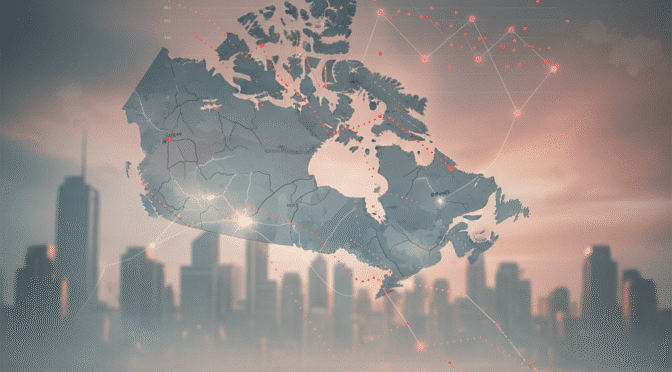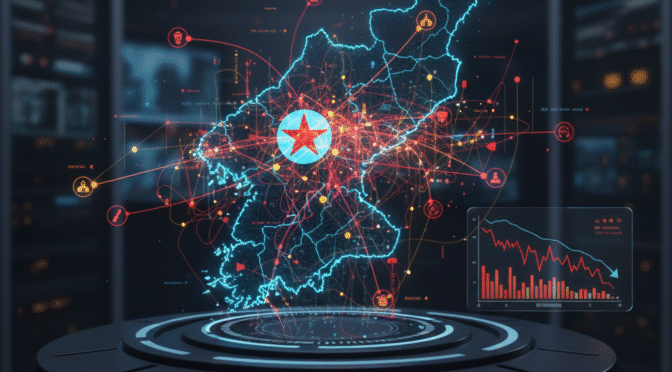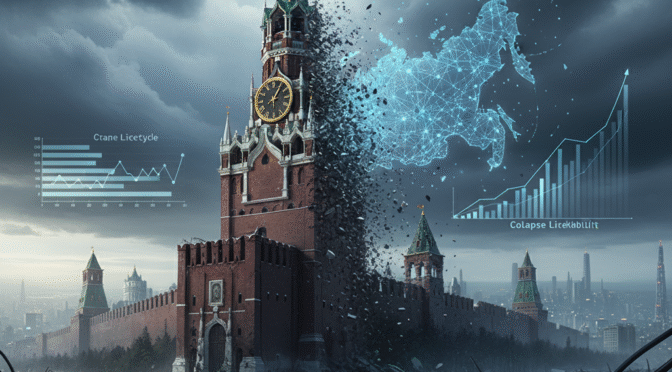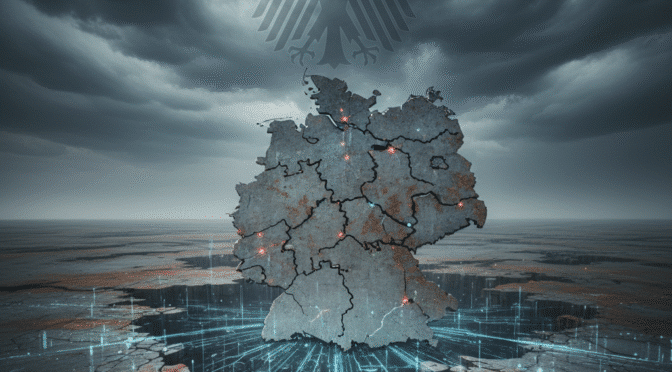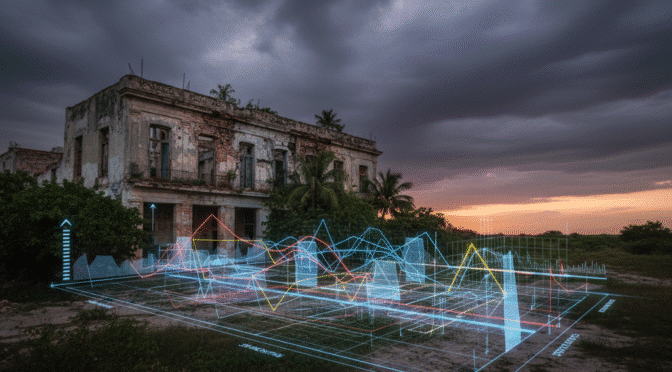- Overall Fragility Score: 5.2 / 10 (Stable but with Accelerating Systemic Decay)
- Lifecycle Stage Assessment: STRESSED
Canada is assessed to be in a Stressed lifecycle stage, characterized by a slow-motion corrosion of its core sources of national resilience. A deep-seated institutional and political complacency has allowed chronic, structural problems to fester, creating a state that is increasingly brittle and ill-prepared for the next major exogenous shock. While Canada’s foundational democratic institutions remain strong and it is far from a crisis state, a convergence of negative trends across the economic and social domains is actively eroding its long-term stability and state capacity. The forecast trajectory is not merely one of deterioration, but of compounding fragility, where unaddressed weaknesses in one domain begin to actively degrade stability in others.
- Key Drivers of Fragility:
- Systemic Household Debt & Housing Crisis: Canada’s household debt-to-disposable income ratio of approximately 175% represents a critical systemic vulnerability, overwhelmingly driven by a housing market severely decoupled from local incomes.1 This creates extreme sensitivity to monetary policy and constrains social mobility, acting as a primary drag on economic dynamism.
- Systemic Degradation of Public Healthcare: The universal healthcare system, a foundational pillar of the Canadian social contract, is in a state of measurable, chronic decline. Historically long wait times for priority procedures, critical health workforce shortages, and increasing reliance on costly temporary staffing solutions are eroding public trust in the state’s ability to deliver its most essential services.3
- Deepening Social and Political Fragmentation: Acrimonious federal-provincial relations, particularly with Alberta and Quebec over jurisdictional and resource issues, are undermining national cohesion.5 Concurrently, the profound failure to advance meaningful reconciliation with Indigenous peoples—evidenced by stalled progress on the Truth and Reconciliation Commission’s (TRC) Calls to Action and new conflicts over resource legislation—presents a foundational challenge to the state’s legitimacy.6
- Chronic Economic Underperformance: A persistent and widening labour productivity gap with the United States and other OECD peers, fueled by chronically low business investment, constrains the long-term economic growth required to fund social services for an aging population and allow households to deleverage sustainably.8
- Forecast Trajectory: Compounding Deterioration. Over the 36-month forecast horizon, Canada is not at risk of state failure. However, the base case is a steady, grinding erosion of economic resilience, social cohesion, and institutional capacity. The accumulation of these stresses significantly raises the probability that a moderate external shock could trigger a disproportionately severe domestic political and economic crisis.
The Canadian Paradox
The central challenge in assessing Canada’s stability lies in a fundamental paradox. On one hand, the country possesses the hallmarks of a highly stable, advanced G7 economy. It maintains a strong rule of law, low levels of corruption, a well-capitalized and resilient banking system, and a federal debt load that, while elevated post-pandemic, remains manageable and compares favourably to its international peers.9 The Parliamentary Budget Officer (PBO) projects the federal debt-to-GDP ratio will decline to 41.6% in 2025-26 and continue a downward trend to 39.2% by 2029-30, well below the G7 average.12 These strengths provide a significant buffer against shocks.
On the other hand, the critical systems that underpin Canada’s social contract and long-term economic vitality are in a state of measurable, chronic decay. The healthcare system is failing to meet the needs of the population, housing has become profoundly unaffordable for a generation, national unity is frayed by regional grievances, and the economy suffers from a long-term productivity deficit that suppresses wage growth.3
This analysis concludes that the former strengths are dangerously masking the severity of the latter weaknesses. The outward appearance of macroeconomic stability and institutional integrity has fostered a deep complacency among policymakers, preventing the proactive and often painful reforms required to address the compounding structural fragilities. The country’s primary risk is not a single, identifiable threat, but the slow, corrosive effect of multiple unaddressed problems that are now beginning to interact and reinforce one another, making the entire system progressively more brittle.
Forecast Trajectory (36-Month Horizon)
The outlook for the Q4 2025 to Q4 2028 period is not for a sudden collapse into crisis, but for a continued, grinding erosion of state capacity, economic dynamism, and social cohesion. The base-case forecast is a “muddling through” scenario where living standards stagnate or decline for a significant portion of the population, public service delivery continues to degrade, and political fragmentation deepens. This trajectory of compounding fragility significantly raises the risk profile of the country. As the state’s inherent “shock absorbers”—fiscal capacity, social trust, institutional legitimacy—are worn thin, its ability to manage the next major crisis is diminished. The probability that a moderate external shock, such as a global recession or a severe trade dispute with the United States, could trigger a disproportionately severe domestic crisis is moderate and rising.
II. Canada Fragility Assessment: A Data-Driven Review
The following dashboard provides a revised, data-driven assessment of Canada’s systemic fragility. Each indicator has been re-evaluated and substantiated with the most current data available, providing a more granular and accurate snapshot of the country’s key vulnerabilities and sources of resilience as of Q4 2025.
| Domain/Indicator | Current Score (1-10) | Trend (Δ) | Volatility | Weighted Impact (%) | Brief Rationale & Key Data Points |
| A. Economic Resilience | |||||
| Public Debt | 5 | ↔ | Med | 10% | Federal debt-to-GDP is projected at 41.6% for 2025-26, elevated but declining and low by G7 standards.9 Provincial debt loads add significant pressure. High sensitivity to interest rate hikes that increase servicing costs. |
| Productivity | 7 | ↓ | Low | 15% | Chronic labour productivity gap with the US. Annual growth was just 0.8% from 2015-2023, well below the OECD average.8 Persistently low business investment signals poor long-term growth prospects. |
| Household Financial Health | 8 | ↓ | High | 25% | Critical vulnerability. Household debt-to-disposable income is ~175%.1 Severe housing affordability crisis. Bank of Canada notes stress is concentrated among non-mortgage holders, a key risk in an unemployment shock.10 |
| B. Political Legitimacy | |||||
| Trust in Institutions | 6 | ↓ | Med | 10% | Trust is eroding, with high public concern over misinformation.14 However, 62% of Canadians believe the federal government respects their privacy rights, and perceptions of intergovernmental cooperation have recently improved.15 |
| Rule of Law | 2 | ↔ | Low | 5% | Strong judicial independence and low corruption. However, rising concerns over foreign interference in democratic processes and legal challenges to federal authority from provinces. |
| C. Social Cohesion | |||||
| Public Service Delivery | 8 | ↓ | Med | 20% | Healthcare system in crisis. Wait times for hip/knee replacements below 2019 benchmarks (61% of knee replacements met targets vs. 70% pre-pandemic).3 Severe workforce shortages in LTC, with RNs down 2.1% since 2021.4 |
| Social Fragmentation | 7 | ↑ | Med | 15% | Deep regional fault lines (Western alienation, Quebec sovereignty). Foundational failure to advance Indigenous reconciliation, with only 13 of 94 TRC Calls to Action completed.6 New resource laws are sparking conflict.7 |
| D. Environmental Security | |||||
| Climate Resilience | 7 | ↓ | High | 0%* | Warming at 2x the global rate. Exposed to catastrophic wildfires. 2023 season burned a record >17M hectares; 2025 season burned >8M ha by September, disrupting infrastructure and the economy.17 |
| Resource Stress | 6 | ↑ | Med | 0%* | Conflicts over resource extraction projects (pipelines, mining) are a constant source of political tension and legal challenges, particularly with Indigenous groups opposing new fast-track legislation like Bill C-5.7 |
| OVERALL FRAGILITY SCORE | 5.2 | 100% | Assessed Lifecycle Stage: STRESSED |
Note: Environmental impacts are weighted within other indicators (e.g., economic costs, social displacement, infrastructure disruption).
III. Core Economic Vulnerabilities: The Debt-Stagnation Trap
A. The Household Debt Overhang
Canada’s most acute and immediate systemic risk emanates not from the state’s balance sheet, but from that of its households. Decades of low interest rates and a relentless rise in housing prices have engineered one of the most leveraged household sectors in the developed world. As of the second quarter of 2025, the ratio of household credit market debt to disposable income stood at 174.9%, meaning Canadians owed nearly $1.75 for every dollar of disposable income.1 This debt, totaling over $3.1 trillion, is overwhelmingly concentrated in mortgages, which account for nearly 75% of the total.1
This extreme leverage creates a profound sensitivity to monetary policy. The household debt service ratio—the share of disposable income required to cover principal and interest payments—remained elevated at 14.4% in Q2 2025.1 This means that interest rate adjustments by the Bank of Canada have a disproportionately large and rapid impact on household finances, constraining consumer spending and threatening economic stability.
Crucially, the Bank of Canada’s 2025 Financial Stability Report adds a critical layer of nuance to this risk. While the overall financial system is assessed as resilient, signs of financial stress are increasing and are currently concentrated among households without a mortgage. Arrears rates on credit cards and auto loans for this cohort have risen above their historical averages.10 This finding is significant because it highlights a key vulnerability: a future economic downturn that leads to a significant rise in unemployment would hit these already-stressed, often lower-income households hardest, potentially triggering a wave of consumer insolvencies that could cascade through the financial system.
B. The Unaffordable Nation
The mountain of household debt is a direct consequence of Canada’s severe and protracted housing affordability crisis. The housing market has been fundamentally decoupled from local economic realities for over a decade. Data from the Canada Mortgage and Housing Corporation (CMHC) illustrates the scale of this decoupling: the national homebuying affordability ratio (the portion of gross household income required for housing costs) surged from an already-high 39% in 2019 to an untenable 54% in 2024.13 In major urban centers, the situation is even more dire, with the ratio reaching 74% in Toronto and an astonishing 99% in Vancouver in 2024.13
The market is characterized by sharp regional disparities. While the high-cost markets of Toronto and Vancouver are now showing signs of stress—including an oversupply of condominiums, a plunge in pre-construction sales, and a wave of project cancellations—more affordable markets like Calgary and Edmonton have remained resilient, posting record-high housing starts in 2025.20 This divergence underscores the localized nature of the crisis but does not mitigate the national systemic risk posed by the sheer scale of the Toronto and Vancouver markets.
Government responses have thus far proven inadequate. Initiatives like the one-time, tax-free $500 housing benefit payment offered in October 2025 are palliative measures that provide temporary relief to low-income households but do nothing to address the core structural driver of the crisis: a chronic and massive supply shortfall.22 The CMHC estimates that Canada needs to build nearly 6 million new homes by 2030 to restore any semblance of affordability, a pace of construction that current housing starts are nowhere near achieving.13 This structural imbalance ensures that housing will remain a primary source of economic and social stress for the foreseeable future.
C. The Productivity Deficit
The intertwined crises of household debt and housing unaffordability are symptoms of a deeper, more foundational economic malaise: Canada’s chronic productivity deficit. For long-term prosperity and stability, an advanced economy must generate sustainable real wage growth, which is overwhelmingly a function of productivity growth. On this front, Canada is failing.
According to the OECD, Canada’s labour productivity grew by a mere 0.8% annually between 2015 and 2023, a rate significantly below the OECD average and considerably behind the United States.8 This is not a new phenomenon but a long-term structural weakness. The 2025 OECD Economic Survey of Canada identifies the primary cause as chronically weak business investment. Canadian firms invest substantially less per worker than their peers in other advanced economies, particularly in key productivity-enhancing areas such as information and communication technology (ICT), machinery and equipment, and intellectual property products.8
This underinvestment is a critical failure. It means Canadian workers are equipped with less advanced tools and technologies than their American counterparts, leading directly to the productivity gap. This, in turn, suppresses the potential for real wage growth. Real wages in Canada in Q1 2025 had yet to fully recover their pre-pandemic levels, remaining 1.4% lower than in Q1 2021.24 Without robust, productivity-driven wage growth, there is no sustainable path for households to deleverage or for incomes to catch up to housing prices, trapping the economy in a precarious low-growth, high-debt paradigm.
The relationship between the housing crisis and the productivity deficit is not coincidental; they are locked in a reinforcing negative feedback loop that constitutes a systemic trap for the Canadian economy. High housing costs force households to dedicate an enormous share of their income and capital to servicing mortgage debt. This has two direct, negative consequences for productivity. First, it suppresses aggregate demand, as households have less disposable income to spend on other goods and services, reducing the incentive for businesses to invest in expansion and efficiency improvements. Second, it causes a massive misallocation of national capital, diverting investment away from innovative, productive sectors of the economy and into non-productive residential real estate.
Simultaneously, the chronically low productivity growth ensures that real wages stagnate. Without the prospect of rising incomes, the only way for new entrants to access the housing market is by taking on ever-larger amounts of debt relative to their earnings, which further inflates the housing bubble and exacerbates the debt problem. This creates a vicious cycle.
This dynamic paralyzes policymakers. The sheer scale of household debt makes the entire economy exquisitely sensitive to interest rate hikes. This forces the Bank of Canada and the federal government to prioritize financial stability above all else. They become deeply reluctant to implement the kind of disruptive but necessary structural reforms—such as significant changes to tax incentives, competition policy, or internal trade rules—that could boost productivity, for fear of inadvertently triggering a housing market collapse and a systemic financial crisis. The problem (housing debt) thus prevents the implementation of the solution (productivity-enhancing reforms). Canada is locked in a low-growth, high-debt equilibrium that becomes progressively more fragile over time.
IV. The Fraying of the Canadian Social Contract
A. The Collapse of a Pillar: The Healthcare Crisis
For a majority of Canadians, the most tangible and politically corrosive failure of the state is the systemic degradation of the universal healthcare system. Once a source of immense national pride and a key pillar of the Canadian identity, the system is now defined by crisis-level wait times, chronic workforce shortages, and an inability to meet the demands of an aging population. This failure to deliver on a core promise of the social contract is uniquely damaging to state legitimacy.
Data from the Canadian Institute for Health Information (CIHI) paints a grim, quantitative picture of this decline. Despite health systems performing a higher volume of many procedures in 2024 compared to pre-pandemic levels in 2019 (e.g., 26% more hip replacements and 21% more knee replacements), the proportion of patients receiving care within the medically recommended timeframe has fallen significantly. In 2024, only 68% of hip replacement patients and 61% of knee replacement patients received their surgery within the 6-month benchmark, down from 75% and 70% respectively in 2019.3 The wait for diagnostic imaging, a critical precursor to treatment, has also lengthened considerably, with the median wait time for an MRI scan increasing by 15 days between 2019 and 2024.3 Emergency departments are under similar strain; for patients admitted to hospital, 9 out of 10 ED visits were completed within a staggering 48.5 hours in 2024-2025.25
The root of this crisis is a catastrophic and worsening health workforce shortage. As of 2023, there were over 29,000 job vacancies for Registered Nurses (RNs) and Registered Psychiatric Nurses (RPNs), and over 13,000 for Licensed Practical Nurses (LPNs).4 The long-term care (LTC) sector, which serves the country’s most vulnerable citizens, is at the epicentre of this workforce collapse. Between 2021 and 2023, the number of LPNs employed in LTC fell by 6.1% and the number of RNs fell by 2.1%.4 To fill the void, LTC facilities have become massively reliant on overtime and expensive private agency staff. Between the 2018-19 and 2023-24 fiscal years, the use of “purchased hours” from private agencies skyrocketed by 238%, while overtime hours surged by 74%.4 This is not a sustainable model of care delivery; it is a system in structural failure.
| Healthcare System Stress Indicators (Canada) | 2019 (Pre-Pandemic) | 2024 | Change |
| % of Knee Replacements Within Benchmark (6 mos.) | 70% | 61% | ↓ 9 pts |
| % of Hip Replacements Within Benchmark (6 mos.) | 75% | 68% | ↓ 7 pts |
| Median Wait Time for MRI Scan | (Baseline) | +15 days | ↑ |
| Median Wait Time for Prostate Cancer Surgery | 41 days | 50 days | ↑ 9 days |
| LTC RN Workforce (vs. 2021) | (Baseline) | -2.1% | ↓ |
| LTC LPN Workforce (vs. 2021) | (Baseline) | -6.1% | ↓ |
| Source: Canadian Institute for Health Information (CIHI) data for 2019-2024.3 |
B. The Cracks in the Federation
Concurrent with the decay of universal social programs, the political and social fabric of the Canadian federation is showing significant signs of strain. Acrimonious disputes between the federal government and several provinces are undermining national cohesion and the ability to implement coherent national policy. Research from the Fraser Institute highlights a pattern of increasing federal spending and policy intrusions into areas of exclusive or shared provincial jurisdiction, such as pollution abatement (spending up 1,741%) and K-12 education (spending up 201%) between 2014-15 and 2023-24.5
This federal activism has generated the most friction in the province of Alberta, where federal climate policies like the carbon tax and new environmental regulations are widely perceived as a direct assault on the province’s vital oil and gas industry. This has fueled a powerful narrative of “Western alienation” and emboldened political movements demanding greater provincial autonomy, such as the creation of a provincial pension plan and police force to replace their federal counterparts.
In Quebec, the sovereignty movement remains a persistent, if currently latent, threat to national unity. Polling in late 2025 reveals a complex and potentially volatile political landscape. While overall support for sovereignty remains stable at approximately 35-44% and a clear majority of Quebecers (49% “very unfavourable”) oppose holding a referendum in the near term, the pro-sovereignty Parti Québécois (PQ) has surged in popularity and now leads all other parties with 38% of voting intentions.27 This disconnect suggests that many voters are turning to the PQ as a vehicle for change and dissatisfaction with the incumbent government, rather than out of a renewed passion for independence. However, it creates a significant latent risk. The election of a majority PQ government in 2026, which has promised a referendum, combined with an unpopular federal government in Ottawa, could easily reactivate the national unity crisis. The symbolic visit of the PQ leader to Alberta in September 2025 to find common cause against the federal government underscores the growing alignment of regional grievances against central authority.30
C. The Unfinished Work of Reconciliation
The most profound and foundational challenge to the legitimacy and long-term stability of the Canadian state is its ongoing failure to achieve meaningful reconciliation with Indigenous peoples. A decade after the release of the Truth and Reconciliation Commission’s Final Report, progress on its 94 Calls to Action has been glacial, breeding deep cynicism and undermining trust.
A September 2025 progress report from the Assembly of First Nations (AFN) provides a damning verdict on the federal government’s efforts. The report found that zero new Calls to Action had been completed in the 2024-2025 year. To date, only 13 of the 94 calls have been fully implemented, with just two of those completions occurring in the past five years.6 The AFN report further argues that progress is not just stalled but is actively being reversed, citing federal budget cuts announced in July 2025 that threaten already underfunded essential programs for First Nations.6 Key initiatives, such as the promised Indigenous Justice Strategy, were announced without any attached funding for implementation.6
This failure to address historical injustices is being compounded by new legislative actions that are creating fresh conflicts. Both the federal government’s Bill C-5 (One Canadian Economy Act) and the Ontario government’s Bill 5 (Protect Ontario by Unleashing our Economy Act) are designed to fast-track major resource and infrastructure projects by streamlining environmental assessments and overriding normal consultation processes.7 First Nations leadership has condemned these bills as a profound violation of their constitutional rights to consultation and consent, warning that by prioritizing resource extraction over treaty rights, these laws will inevitably lead to legal challenges, protests, and “conflict on the ground”.7 This approach not only undermines the stated goal of reconciliation but also creates significant legal and operational uncertainty for the resource sector, posing a direct risk to future economic development.
| Progress on TRC Calls to Action (as of Sept 2025) | Status |
| Total Calls to Action | 94 |
| Completed to Date | 13 |
| Completed in 2024-2025 | 0 |
| Key Challenges | Lack of political will, federal budget cuts threatening implementation, failure to fund key strategies (e.g., Indigenous Justice Strategy), new legislation bypassing consultation rights. |
| Source: Assembly of First Nations (AFN).6 |
The various threads of Canada’s social fragility—the decay of universal services, regional alienation, and the failure of reconciliation—are not independent problems. They are interconnected elements in a cascading crisis of state legitimacy. This cascade begins with a universal grievance that affects all citizens, which then acts as a catalyst, amplifying and validating more specific regional and foundational challenges to the authority of the federal government.
The process begins with the tangible failure of a universally cherished program like healthcare. An average citizen in any province who experiences a multi-day wait in an emergency room or sees a loved one’s surgery postponed indefinitely develops a baseline of dissatisfaction with government competence. This erodes public trust at the most fundamental level of service delivery.
This universal grievance is then refracted through the prism of regional identity. An Albertan, for instance, experiences the same healthcare failure but simultaneously views the federal government as imposing punitive climate policies that threaten their livelihood. Their general dissatisfaction with government incompetence is now compounded by a specific narrative of regional exploitation and alienation. The federal government is no longer just inept; it is perceived as actively hostile to their region’s interests.
Finally, this is layered upon the foundational, unresolved colonial relationship with Indigenous peoples. A First Nations community experiences the healthcare crisis (often far more acutely than the general population), endures systemic economic marginalization, and then witnesses the passage of new federal legislation that explicitly overrides their constitutionally protected rights to consultation on a resource project in their traditional territory. For this community, the crisis of confidence is not merely about competence or regional fairness; it is about the fundamental legitimacy of the Canadian state’s sovereignty and the entire legal framework upon which it is built.
The result is a multi-front, cascading crisis of legitimacy. A universal failure primes the population for discontent, which is then channeled and intensified along pre-existing regional and historical fault lines. This makes it exceedingly difficult for any federal government to build a national consensus for action on any major file, as it faces different, and often contradictory, legitimacy deficits across the country.
V. Climate Shocks as a Systemic Risk Multiplier
Canada is a climate vulnerability hotspot, warming at twice the global average rate.18 In recent years, the escalating frequency and intensity of climate-related disasters, particularly catastrophic wildfires, have ceased to be isolated environmental events. They now function as a systemic risk multiplier, a powerful catalyst that actively strains Canada’s public finances, disrupts its economy, and overwhelms its state capacity, thereby amplifying all other identified fragilities.
The wildfire seasons of 2023 and 2025 provided a stark preview of this new reality. The 2023 season was the most destructive in Canadian history, burning an unprecedented 16.5 to 18 million hectares of land—more than double the previous record.17 The 2025 season continued this severe trend, scorching over 8.3 million hectares by early September and ranking as potentially the second-worst season on record.17
These events inflict staggering direct and indirect costs, acting as a powerful economic multiplier of fragility. The 2024 Jasper wildfire, for example, caused an estimated $1.3 billion in insured damages, destroyed 358 homes and businesses, and crippled the local tourism-dependent economy, with park visitation collapsing by 54% year-over-year.17 Beyond the immediate destruction, these mega-fires disrupt critical national infrastructure. Smoke and fire risk forced the temporary suspension of CN Rail services near Jasper, delaying the movement of grain and other goods to the Port of Vancouver for export.17 These disruptions ripple through supply chains, harming sectors far from the fire line.
The fiscal impact is equally severe. The direct cost of wildfire protection in Canada has been rising by approximately $150 million per decade since the 1970s.31 The multi-billion-dollar costs of emergency response and post-disaster recovery place an immense and unplanned strain on both federal and provincial budgets. This diverts critical financial resources that could otherwise be allocated to addressing other chronic fragilities, such as funding healthcare, building affordable housing, or investing in productivity-enhancing infrastructure.
Finally, these climate shocks act as a social multiplier. Wildfire smoke blankets cities thousands of kilometres away, causing widespread air quality alerts and posing serious health risks, which in turn places additional stress on already-overwhelmed healthcare systems.31 Critically, the burden of these disasters falls disproportionately on Indigenous communities. Between 1980 and 2021, over 42% of all wildfire evacuations in Canada were from majority-Indigenous communities, further traumatizing populations and straining the already fraught relationship between Indigenous peoples and the state.31 Each catastrophic fire season demonstrates the state’s limited capacity to protect its citizens from predictable 21st-century threats, further eroding its legitimacy.
VI. Synthesis and Predictive Outlook (2026-2028)
A. Critical Reinforcing Feedback Loops
Canada’s fragility is not the result of a single point of failure but of multiple, interacting stressors that have created self-perpetuating negative cycles. These feedback loops entrench structural problems, paralyze policy responses, and accelerate the erosion of national resilience.
- The Housing-Stagnation Trap: As detailed previously, extreme housing costs force households into massive debt, which suppresses domestic consumption and misallocates capital away from productive investment. The resulting low productivity growth prevents the real wage gains necessary for incomes to catch up to house prices. Fear of triggering a housing crash and financial crisis in a highly leveraged population prevents policymakers from enacting the bold reforms needed to boost productivity, thus locking the economy in a low-growth, high-debt paradigm.
- The Healthcare Decay -> Legitimacy Erosion Loop: An aging population, chronic underfunding, and severe workforce shortages lead to the tangible degradation of healthcare services, manifested in historically long wait times. This visible failure of a cherished national institution directly erodes public trust in government competence and the value of the Canadian social contract. This loss of trust and political capital makes it exceedingly difficult for governments to implement the necessary but politically painful reforms (e.g., significant tax increases, service reorganization) required to fix the system, thus ensuring its continued decline.
- The Resource Alienation -> National Unity Spiral: Federal climate policies, which are often supported in central Canada, are perceived in energy-producing provinces like Alberta as a direct attack on their core industry and economic viability. This perception fuels a powerful sense of Western alienation, leading to direct political and legal challenges to federal authority (e.g., provincial “sovereignty” acts). This open defiance weakens national cohesion and the federal government’s capacity to implement any national-scale project, which in turn reinforces the perception in the West that the federation no longer serves its interests, driving a spiral of fragmentation.
B. Scenarios and Tipping Points
Most Likely Scenario (75% Probability): The Grinding Decline.
Over the 36-month forecast horizon, Canada is most likely to avoid a full-blown, acute crisis. Instead, it will continue on its current trajectory of slow, systemic decay. Economic growth will remain anemic, failing to keep pace with population growth and leading to a decline in per capita GDP. Housing affordability will continue to worsen, particularly for younger generations. Healthcare wait times will lengthen further as workforce shortages persist, and public dissatisfaction will grow. Federal-provincial and federal-Indigenous relations will remain acrimonious and characterized by legal and political standoffs. The overall resilience of the state will continue to erode, leaving it progressively more vulnerable to shocks that may occur beyond the 36-month horizon. This scenario represents a future of managed decline, characterized by political stagnation and a fraying social fabric.
Reasonable Worst-Case Scenario (15% Probability): The Converging Crisis.
A global economic shock in 2026, such as a sharp recession or a severe trade war with the United States, acts as the primary trigger. Persistently elevated interest rates, combined with a spike in unemployment, finally cause the Canadian housing market to undergo a severe and disorderly correction, with prices falling by over 35%. This leads to a wave of mortgage defaults and consumer insolvencies, placing one or more of Canada’s six major banks under severe stress and requiring a massive public bailout, as warned by the Bank of Canada.10 The resulting deep recession causes a fiscal crisis for both federal and provincial governments, forcing austerity measures that further degrade public services.
Amid this economic turmoil, the political fault lines fracture. A newly elected sovereigntist government in Quebec, capitalizing on the crisis, announces its intention to hold a referendum on independence by 2028. Simultaneously, the government of Alberta uses the crisis to push for radical constitutional changes under its “sovereignty” agenda, effectively opting out of key federal programs and challenging federal jurisdiction over its resources. The federal government, crippled by the economic and fiscal crisis and facing existential secessionist threats on two fronts, lacks the political capital and financial capacity to manage the situation, leading to a profound constitutional crisis, capital flight, and a potential breakup of the federation.
C. Concluding Assessment and Key Tipping Points to Monitor
Canada remains a fundamentally stable country, but its key sources of resilience—economic dynamism, a functioning social safety net, and national unity—are being steadily and measurably eroded by chronic, unaddressed structural problems. The state’s primary challenge is a deep-seated complacency that prevents proactive reform, allowing vulnerabilities to compound over time. The probability of a transition to a ‘Crisis’ stage is low within the 36-month horizon but is not negligible and is increasing.
Probability of transitioning to a ‘Crisis’ stage within 36 months is assessed as low-to-moderate (15%).
Key Tipping Points that could trigger this transition include:
- Economic Tipping Point: A rise in the national unemployment rate of more than 2 percentage points within a six-month period. This would likely trigger a wave of defaults among the highly leveraged non-mortgage holding households identified as a key risk by the Bank of Canada, potentially initiating a systemic financial crisis.10
- Social Tipping Point: The sustained, multi-province collapse of essential services (e.g., the widespread, indefinite closure of hospital emergency rooms) leading to large-scale civil disobedience or tax revolts that overwhelm law enforcement capacity and signal a complete breakdown of the social contract.
- Political Tipping Point: The election of a majority Parti Québécois government in the 2026 Quebec provincial election that subsequently wins a Supreme Court reference case affirming its right to hold a referendum on a simple, unilateral question of independence. This legal victory would trigger a full-blown and potentially irreversible national unity crisis.
If you find this post useful, please share the link on Facebook, with your friends, etc. Your support is much appreciated and if you have any feedback, please email me at in**@*********ps.com. Please note that for links to other websites, we are only paid if there is an affiliate program such as Avantlink, Impact, Amazon and eBay and only if you purchase something. If you’d like to directly contribute towards our continued reporting, please visit our funding page.
Sources Used
- The Daily — National balance sheet and financial flow accounts …, accessed October 8, 2025, https://www150.statcan.gc.ca/n1/daily-quotidien/250911/dq250911a-eng.htm
- Household debt-to-income ratio ticks higher in Q2 – Investment Executive, accessed October 8, 2025, https://www.investmentexecutive.com/news/research-and-markets/household-debt-to-income-ratio-ticks-higher-in-q2/
- Wait times for priority procedures in Canada, 2025 | CIHI, accessed October 8, 2025, https://www.cihi.ca/en/wait-times-for-priority-procedures-in-canada-2025
- Recent staffing and quality indicator trends in Canadian long-term …, accessed October 8, 2025, https://www.cihi.ca/en/recent-staffing-and-quality-indicator-trends-in-canadian-long-term-care
- Stay-in-Your-Lane Federalism: Keeping the Peace in Federal …, accessed October 8, 2025, https://www.fraserinstitute.org/studies/stay-in-your-lane-federalism-keeping-peace-federal-provincial-relations
- Progress on Realizing the Truth and Reconciliation Commission’s …, accessed October 8, 2025, https://afn.bynder.com/m/21a223c344077b7/original/Progress-on-Realizing-the-Truth-and-Reconciliation-Commission-s-Calls-to-Action-September-2025.pdf
- Protecting Our Lands: A First Nations Response to Bill 5 & Bill C-5 …, accessed October 8, 2025, https://chiefs-of-ontario.org/resources/protecting-our-lands/
- What Canada Must Do Now to Strengthen Productivity: OECD …, accessed October 8, 2025, https://thefutureeconomy.ca/op-eds/what-canada-must-do-now-to-strengthen-productivity-oecd-economic-survey-of-canada/
- Archived – Department of Finance Canada 2024–25 Departmental plan, accessed October 8, 2025, https://www.canada.ca/en/department-finance/corporate/transparency/plans-performance/departmental-plans/2024-2025/dp-full-page.html
- Financial Stability Report—2025 – Bank of Canada, accessed October 8, 2025, https://www.bankofcanada.ca/2025/05/financial-stability-report-2025/
- Canada: Financial System Stability Assessment-Press Release and Staff Report, accessed October 8, 2025, https://www.imf.org/en/Publications/CR/Issues/2025/07/31/Canada-Financial-System-Stability-Assessment-Press-Release-and-Staff-Report-569167
- Economic and Fiscal Outlook – March 2025, accessed October 8, 2025, https://www.pbo-dpb.ca/en/publications/RP-2425-030-S–economic-fiscal-outlook-march-2025–perspectives-economiques-financieres-mars-2025
- Canada’s Housing Supply Shortages: Moving to a New Framework – CMHC, accessed October 8, 2025, https://www.cmhc-schl.gc.ca/professionals/housing-markets-data-and-research/housing-research/research-reports/accelerate-supply/canadas-housing-supply-shortages-a-new-framework
- Concern about misinformation: Connections to trust in media, confidence in institutions, civic engagement, and hopefulness – Statistique Canada, accessed October 8, 2025, https://www150.statcan.gc.ca/n1/pub/75-006-x/2025001/article/00008-eng.htm
- 2024-2025 Public Opinion Research on Privacy Issues, accessed October 8, 2025, https://www.priv.gc.ca/en/opc-actions-and-decisions/research/explore-privacy-research/2025/por_ca_2024-25/
- Working together in the Canadian federation – Environics Institute, accessed October 8, 2025, https://www.environicsinstitute.org/projects/project-details/working-together-in-the-canadian-federation
- Canada’s wildfire crisis: Economic & trade disruption | EDC, accessed October 8, 2025, https://www.edc.ca/en/article/2025-wildfires-impact-canadian-trade.html
- Canada wildfire season already second worst on record as experts warn of ‘new reality’, accessed October 8, 2025, https://www.theguardian.com/world/2025/aug/11/canada-wildfire-season
- Q2 Canadian household net worth rises again despite economic uncertainties – RBC, accessed October 8, 2025, https://www.rbc.com/en/thought-leadership/economics/featured-insights/q2-canadian-household-net-worth-rises-again-despite-economic-uncertainties/
- Fall 2025 Housing Supply Report – CMHC, accessed October 8, 2025, https://www.cmhc-schl.gc.ca/professionals/housing-markets-data-and-research/market-reports/housing-market/housing-supply-report
- Canada Housing Market 2024-2025: Recovery Amid Affordability Strains – BuildCheck AI, accessed October 8, 2025, https://buildcheck.ai/insights-case-studies/canada-housing-market-2024-2025-recovery-amid-affordability-strains
- Canada Housing Benefit $500 Payment in October 2025: Are You Eligible to Get it?, accessed October 8, 2025, https://cfihaiti.com/en/canada-housing-benefit-500-payment/
- OECD Economic Surveys: Canada 2025, accessed October 8, 2025, https://www.oecd.org/en/publications/oecd-economic-surveys-canada-2025_28f9e02c-en.html
- OECD Employment Outlook 2025: Canada, accessed October 8, 2025, https://www.oecd.org/en/publications/oecd-employment-outlook-2025-country-notes_f91531f7-en/canada_7843efa6-en.html
- NACRS emergency department visits and lengths of stay | CIHI, accessed October 8, 2025, https://www.cihi.ca/en/nacrs-emergency-department-visits-and-lengths-of-stay
- Wait times for priority procedures, 2019 to 2024: Insights into trends and contributing factors, accessed October 8, 2025, https://www.cihi.ca/en/wait-times-for-priority-procedures-2019-to-2024-insights-into-trends-and-contributing-factors
- Most Quebecers reject holding referendum on … – CTV News, accessed October 8, 2025, https://www.ctvnews.ca/montreal/article/most-quebecers-againt-holding-sovereignty-referendum-poll/
- Majority of young Quebecers back independence: poll – CTV News, accessed October 8, 2025, https://www.ctvnews.ca/montreal/article/majority-of-young-quebecers-back-independence-poll/
- 30 years on, is Quebec headed for another independence referendum? | CBC News, accessed October 8, 2025, https://www.cbc.ca/news/canada/montreal/pq-independence-referendum-1.7423259
- MEDIA ADVISORY – Conference of the leader of the Parti Québécois in Alberta, accessed October 8, 2025, https://www.quebec.ca/en/news/actualites/detail/media-advisory-conference-of-the-leader-of-the-parti-quebecois-in-alberta-64893
- FACT SHEET: Climate change and wildfires in Canada, accessed October 8, 2025, https://climateinstitute.ca/news/fact-sheet-wildfires/
- Canada’s 2025 wildfire season: A national emergency – The Brock Press, accessed October 8, 2025, https://brockpress.com/canadas-2025-wildfire-season-a-national-emergency/
